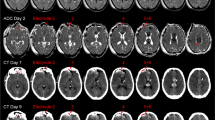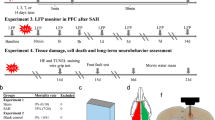Abstract
Objects
The “re-build up” phenomenon is a pathognomonic finding induced after hyperventilation in pediatric moyamoya disease, and is closely related to ischemic attacks. However, its precise mechanism remains unknown.
Methods
In this study, MEG, MRI, and SPECT were used to clarify its mechanism in 4 children with moyamoya disease. Cerebral blood flow before and after acetazolamide administration was measured. Spontaneous magnetic brain activity was measured using a whole-head MEG system. The quantified dipole distribution was shown on 3D-MRI.
Results and conclusion
The original current dipoles of the “re-build up” slow waves were predominantly located in the deep cortical sulci in the area with impaired reactivity to acetazolamide. The results suggested that the re-build up waves derive from the deep cortical sulci due to the reduction in the cerebral perfusion reserve.

Similar content being viewed by others
References
Kamada K, Takeuchi F, Harada T, Qiao B, Houkin K, Kuriki S, Iwasaki Y, Mitsumori K (2001) Enhanced late components of AEFs associated with the temporal lobe lesions. Neuroreport 12:1297–1300
Kamada K, Moller M, Saguer M, Ganslandt O, Kaltenhauser M, Kober H, Vieth J (2001) A combined study of tumor-related brain lesions using MEG and proton MR spectroscopic imaging. J Neurol Sci 186:13–21
Kameyama M, Shirane R, Tsurumi Y, Takahashi A, Fujiwara S, Suzuki J, Ito M, Ido T (1986) Evaluation of cerebral blood flow and metabolism in childhood moyamoya disease: an investigation into “re-build-up” on EEG by positron CT. Childs Nerv Syst 2:130–133
Kazumata K, Kuroda S, Houkin K, Abe H, Mitumori K (1996) Regional cerebral hemodynamics during re-build-up phenomenon in childhood moyamoya disease. An analysis using99mTc-HMPAO SPECT. Childs Nerv Syst 12:161–165
Kodama N, Aoki Y, Hiraga H, Wada T, Suzuki J (1979) Electroencephalographic findings in children with moyamoya disease. Arch Neurol 36:16–19
Kuroda S, Kamiyama H, Isobe M, Houkin K, Abe H, Mitsumori K (1995) Cerebral hemodynamics and “re-build-up” phenomenon on electroencephalogram in children with moyamoya disease. Childs Nerv Syst 11:214–219
Kuroda S, Houkin K, Hoshi Y, Tamura M, Kazumata K, Abe H (1996) Cerebral hypoxia after hyperventilation causes “re-build-up” phenomenon and TIA in childhood moyamoya disease. A near-infrared spectroscopy study. Childs Nerv Syst 12:448–453
Kuroda S, Houkin K, Kamiyama H, Mitsumori K, Iwasaki Y, Abe H (2001) Long-term prognosis of medically treated patients with internal carotid or middle cerebral artery occlusion: can acetazolamide test predict it? Stroke 32:2110–2116
Lin Y, Yoshiko K, Negoro T, Watanabe K, Negoro M (2000) Cerebral oxygenation state in childhood moyamoya disease: a near-infrared spectroscopy study. Pediatr Neurol 22:365–369
Ohyama H, Niizuma H, Fujiwara S, Suzuki J (1985) EEG findings in moyamoya disease in children—with special reference to the genesis of re-build up (in Japanese). No Shinkei Geka 13:727–733
Suzuki J, Takaku A (1969) Cerebrovascular “moyamoya” disease. Disease showing abnormal net-like vessels in base of brain. Arch Neurol 20:288–299
Acknowledgment
This study was partly supported by a grant from the Research Committee on Moyamoya Disease, sponsored by the Ministry of Health, Labor, and Welfare of Japan.
Author information
Authors and Affiliations
Corresponding author
Rights and permissions
About this article
Cite this article
Qiao, F., Kuroda, S., Kamada, K. et al. Source localization of the re-build up phenomenon in pediatric moyamoya disease—a dipole distribution analysis using MEG and SPECT. Childs Nerv Syst 19, 760–764 (2003). https://doi.org/10.1007/s00381-003-0818-x
Received:
Published:
Issue Date:
DOI: https://doi.org/10.1007/s00381-003-0818-x




